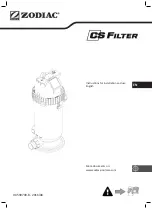
-13-
reported as Percent Rejection. If the feed water
con tained 100 ppm of T.D.S. and the product water
con tained 10 ppm of T.D.S., 90 ppm have been
re ject ed and the reject ratio is 90%.
Percent = Feed T.D.S. - Product T.D.S. x 100%
Rejection
Feed T.D.S.
B. Water Quantity
1) Water quantity is termed Flux or Product Water
Rate and is measured as the amount of water pro-
duced in one day. It is reported as Gallons per Day
(gpd) or as Milliliters per Minute (ml/min).
2) The flow of water to drain is the Reject Water Rate
and is measured as Gallons per day (gpd) or
Milliliters per Minute (ml/min).
Milliliters per minute x .38 = gallons per day
EXAMPLE:
The drain flow will fill a graduated cyl in-
der to the 105 ml mark in one minute.
105 ml/min. x .38 = 40 gpd
If the container available measures ounces, use the
following conversion:
Ounces per minute x 11.2 = gallons per day
3) The Reject Ratio is the amount of water pro duced
compared to the amount of water flowing to drain.
Reject Ratio = Reject Rate
Product Rate
4) The Percent Recovery is another way to mea sure
the amount of water produced as compared to the
amount actually used.
% Recovery = Prod uct Rate x 100%
Feed Rate
NOTE:
The total flow or feed wa ter rate into
the system is the sum of the product
flow and the drain flow.
C. Water Pressure and Temperature
Most R.O. Membranes are rated at a stan dard ized
condition of 77°F (25°C) and 60 psi (414 kPa) dis charg-
ing to atmospheric pressure.
Product water quality and quantity greatly de pend
upon the Net Pressure Differential (
∆
p) across the R.O.
Mem brane. This pressure differential is a summation of
the feed water pressure at the Mem brane, which tries
to push the water through, the pres sure in the Hold-
ing Tanks, which tries to push the water backwards
and the osmotic pres sure, which also tries to push the
water back wards.
The Osmotic Pressure is in proportion to the dis solved
minerals in the water and can be approximated by 1
psi for each 100 ppm of T.D.S.
The higher the net pressure differential, the higher the
quantity and quality of water produced.
Some loss of production when using a pressurized
Holding Tank is normal.
Feed Water Temperature also has an affect on water
production. The lower the temperature, the lower the
quan ti ty of water produced (see Table 3, page 13)
Water Production Rate = Rated Flow
x Pressure Cor rec tion
x Temperature Correction
TABLE 1:
Pressure Correction factors for Thin Film Composite
(T.F.C.) Membrane Production Rate
Pressure
Correction
Percent
∆
psi
∆
kPa Factor Rejection*
10 69
.17
84
15 103
.25
88
20 138
.33
90
25 172
.42
92
30 207
.50
93
35 241
.58
93
40 276
.67
94
45 310
.75
94
50 345
.83
94
55 379
.92
94
60 414
1.00
94
65 448
1.08
94
70 483
1.17
95
75 517
1.25
95
80 552
1.33
95
85 586
1.42
95
90 621
1.50
96
95 655
1.58
96
100 689
1.67
96
To adjust form 60 psi (414)kPa) to another pressure multiply the pro-
duction rate by the correction factor. To adjust from given pressure
to standard conditions divide by the factor.
*Percent rejection of Total Dissolved Solids
Содержание Aqua Classic
Страница 2: ......






































